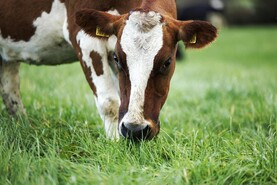The mild weather has increased soil temperatures in recent days and now that moisture is not limiting in practically any area, growth has responded.
According to Teagasc PastureBase figures, those measuring grass have increased the number of days grazing ahead by over three days in the last week.
This is positive news, but in many cases farms were starting from a low base and the amount of grass on farm is well below where it should be at this time of the year.
Ideally this week would see peak average farm cover on farm as we look to carry decent covers into autumn to extend the grazing season.
In reality however, farms are running 30% to 40% behind this target and while the growth rates have increased significantly, so too has the rate at which stock is moving through grass.
Now the focus must be on making the most of what grass is available. Avoid any temptation to remove supplementation from stock at grass where it is being offered.
Prioritise stock at grass from now on. On the Thrive demonstration farm all finishing stock have been housed for a number of weeks for finishing to allow this year’s calves stay out at grass over the coming weeks.
This not only benefits the calves but we are seeing the finishing stock perform very well indoors, settled on their finishing diet.
The priority stock will differ on everyone’s farm depending on your farm system, but identify what stock you want to hold out for the longest and set up the final grazing rotation to do so.
On spring calving suckler herds weaning should now be commencing with at least first calvers to allow them time to recover some condition pre-housing.
Culls and those that calved early in the season could also be earmarked for weaning in the next week to 10 days in order to reduce grass demand.
Shaun Diver – Tullamore Farm, Co Offaly
Growth has improved, which has increased the average farm cover but it is still low for this time of year. I would normally have the highest average farm cover of the year this week to carry us into autumn, but there is no such luxury this year.
I have 34 cows weaned to reduce demand. These are first calved heifers, cull cows and the earliest calved cows. They are housed and are on hay to dry them off.
Culls will be fed on for a few weeks prior to slaughter.
I have drafted 30 lambs for slaughter later this week. The ram lambs are getting 0.5kg/day concentrate while the ewe lambs are getting 0.3kg/day.
I have increased drafting weights to 47-50kg and they are handling much better than they were at the last draft.
System Suckler to beef
Soil type Variable
Farm cover (kg DM/ha) 679
Growth (kg DM/ha/day) 44
Demand (kg DM/ha/day) 23
Oisín Kennedy – Aclare, Co Sligo
Growth has kicked on in the last 10 days which was needed. We spread around 30 units/ac of nitrogen before the closing date to boost grass supply for the coming weeks.
Ground conditions are nearly perfect, which is a real bonus as we head towards the end of September. Hopefully we have enough grass to keep cows and calves out until late-October depending on weather.
The plan is to bring everything in next week to scan the cows as well as weigh all stock for the BEEP-S scheme. We will dung sample the calves later this week and dose them if necessary.
They are creep grazing ahead of the cows and have been offered creep feed for the last month, but intake is still low given how good grass quality is.
System Suckler to beef and sheep
Soil type Heavy
Farm cover (kg DM/ha) 838
Growth (kg DM/ha/day) 44
Demand (kg DM/ha/day) 35
Declan Marren – THRIVE Farm, Co Tipperary
The first of the heifers were drafted for slaughter this week, with 12 Hereford heifers killed on Monday at an average carcase weight of 280kg.
A batch of Angus heifers will be slaughtered later in the week and a full report of performance will be in next week’s paper.
All finishing cattle are housed, with heifers in for a month and bullocks a fortnight due to the lack of grass growth.
There is plenty of grass for this year’s calves and we should have sufficient grass supply to see them well into November.
Housing the finishing cattle does come at some extra cost in terms of silage and slurry handling costs, but meal feeding rates remain the same. On the plus side, cattle are very settled and thriving well indoors pre-slaughter.
System Dairy calf to beef
Soil type Mostly dry
Farm cover (kg DM/ha) 791
Growth (kg DM/ha/day) 29
Demand (kg DM/ha/day) 22






 This is a subscriber-only article
This is a subscriber-only article











SHARING OPTIONS: